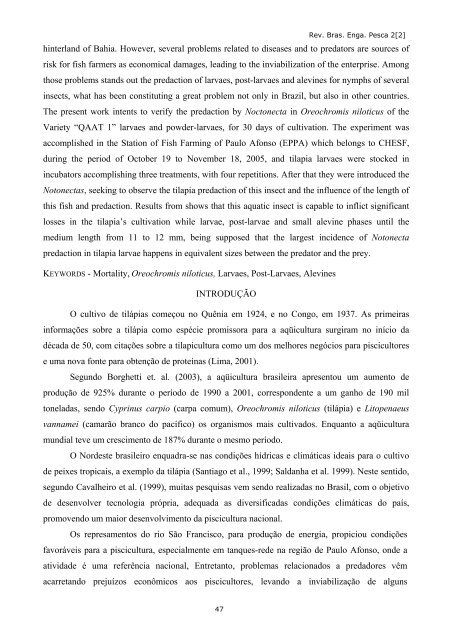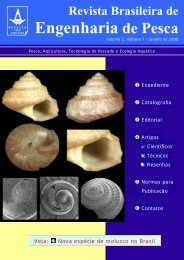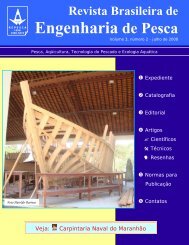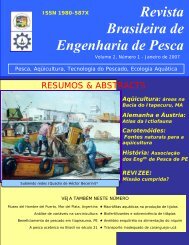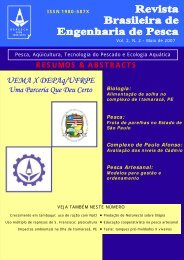Revista Repesca - Engenharia de Pesca - Uema
Revista Repesca - Engenharia de Pesca - Uema
Revista Repesca - Engenharia de Pesca - Uema
You also want an ePaper? Increase the reach of your titles
YUMPU automatically turns print PDFs into web optimized ePapers that Google loves.
Rev. Bras. Enga. <strong>Pesca</strong> 2[2]<br />
hinterland of Bahia. However, several problems related to diseases and to predators are sources of<br />
risk for fish farmers as economical damages, leading to the inviabilization of the enterprise. Among<br />
those problems stands out the predaction of larvaes, post-larvaes and alevines for nymphs of several<br />
insects, what has been constituting a great problem not only in Brazil, but also in other countries.<br />
The present work intents to verify the predaction by Noctonecta in Oreochromis niloticus of the<br />
Variety “QAAT 1” larvaes and pow<strong>de</strong>r-larvaes, for 30 days of cultivation. The experiment was<br />
accomplished in the Station of Fish Farming of Paulo Afonso (EPPA) which belongs to CHESF,<br />
during the period of October 19 to November 18, 2005, and tilapia larvaes were stocked in<br />
incubators accomplishing three treatments, with four repetitions. After that they were introduced the<br />
Notonectas, seeking to observe the tilapia predaction of this insect and the influence of the length of<br />
this fish and predaction. Results from shows that this aquatic insect is capable to inflict significant<br />
losses in the tilapia’s cultivation while larvae, post-larvae and small alevine phases until the<br />
medium length from 11 to 12 mm, being supposed that the largest inci<strong>de</strong>nce of Notonecta<br />
predaction in tilapia larvae happens in equivalent sizes between the predator and the prey.<br />
KEYWORDS - Mortality, Oreochromis niloticus, Larvaes, Post-Larvaes, Alevines<br />
INTRODUÇÃO<br />
O cultivo <strong>de</strong> tilápias começou no Quênia em 1924, e no Congo, em 1937. As primeiras<br />
informações sobre a tilápia como espécie promissora para a aqüicultura surgiram no início da<br />
década <strong>de</strong> 50, com citações sobre a tilapicultura como um dos melhores negócios para piscicultores<br />
e uma nova fonte para obtenção <strong>de</strong> proteínas (Lima, 2001).<br />
Segundo Borghetti et. al. (2003), a aqüicultura brasileira apresentou um aumento <strong>de</strong><br />
produção <strong>de</strong> 925% durante o período <strong>de</strong> 1990 a 2001, correspon<strong>de</strong>nte a um ganho <strong>de</strong> 190 mil<br />
toneladas, sendo Cyprinus carpio (carpa comum), Oreochromis niloticus (tilápia) e Litopenaeus<br />
vannamei (camarão branco do pacífico) os organismos mais cultivados. Enquanto a aqüicultura<br />
mundial teve um crescimento <strong>de</strong> 187% durante o mesmo período.<br />
O Nor<strong>de</strong>ste brasileiro enquadra-se nas condições hídricas e climáticas i<strong>de</strong>ais para o cultivo<br />
<strong>de</strong> peixes tropicais, a exemplo da tilápia (Santiago et al., 1999; Saldanha et al. 1999). Neste sentido,<br />
segundo Cavalheiro et al. (1999), muitas pesquisas vem sendo realizadas no Brasil, com o objetivo<br />
<strong>de</strong> <strong>de</strong>senvolver tecnologia própria, a<strong>de</strong>quada as diversificadas condições climáticas do país,<br />
promovendo um maior <strong>de</strong>senvolvimento da piscicultura nacional.<br />
Os represamentos do rio São Francisco, para produção <strong>de</strong> energia, propiciou condições<br />
favoráveis para a piscicultura, especialmente em tanques-re<strong>de</strong> na região <strong>de</strong> Paulo Afonso, on<strong>de</strong> a<br />
ativida<strong>de</strong> é uma referência nacional, Entretanto, problemas relacionados a predadores vêm<br />
acarretando prejuízos econômicos aos piscicultores, levando a inviabilização <strong>de</strong> alguns<br />
47


